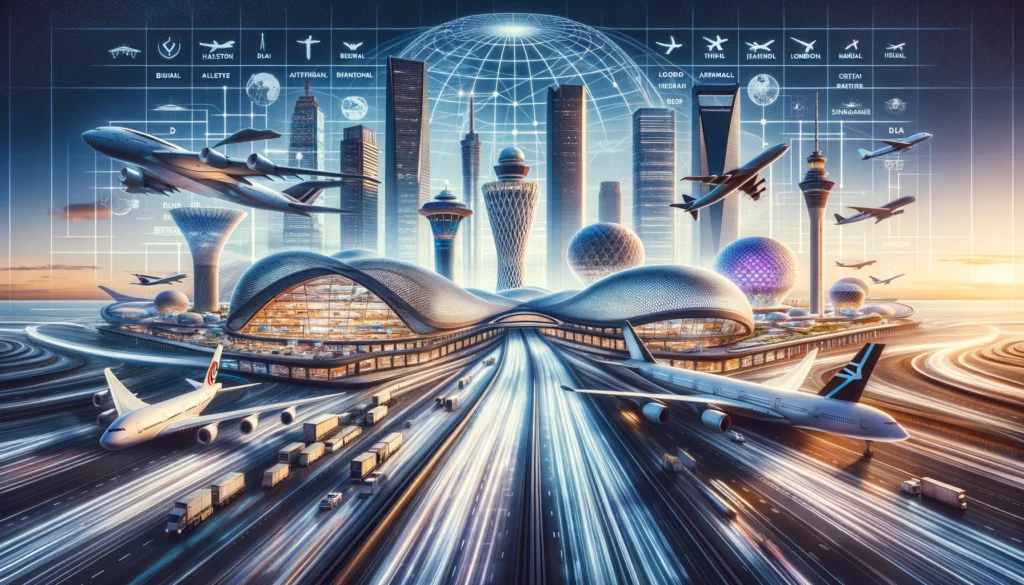top 7 Airports in the World

era defined by global connectivity, airports are not just transit points but the beating heart of international travel and commerce. The year 2024 witnesses the prominence of colossal airports, marvels of engineering and hubs of activity that connect distant corners of the world. Let’s embark on a journey to explore the seven largest airports globally, each a city within a city, showcasing innovation, efficiency, and a commitment to enhancing the passenger experience.


The Sky Giants: Unveiling the 7 Largest Airports in the World
1.Hartsfield-Jackson Atlanta International Airport (ATL), USA
At the pinnacle of the aviation world stands the Hartsfield-Jackson Atlanta International Airport. Known for its sprawling complex and as a nexus for air traffic, ATL has held the title of the busiest airport by passenger volume for years. Its success lies in a seamless blend of operational efficiency, a vast network of flights, and a keen focus on sustainability. With initiatives aimed at reducing environmental impact and enhancing passenger experience, ATL exemplifies the future of air travel.
2. Beijing Daxing International Airport (PKX), China
Emerging as an architectural marvel, Beijing Daxing International Airport is designed to accommodate the future’s demands. Its iconic starfish shape minimizes walking distances for passengers, reflecting a thoughtful integration of design and functionality. PKX stands out for its use of green technology and aims to set a new standard in eco-friendly travel. As a crucial hub in the Asia-Pacific region, it is pivotal in connecting China with the world.
3. Dubai International Airport (DXB), UAE
Dubai International Airport is the embodiment of luxury in the aviation industry. Situated at the crossroads of East and West, DXB is more than an airport; it’s a destination offering unparalleled services and amenities. From opulent lounges to extensive retail spaces, it provides a unique travel experience for passengers in transit. Its strategic location and investment in world-class facilities have cemented DXB’s position as a leading global hub.
4. Istanbul Airport (IST), Turkey
Istanbul Airport, with ambitions to be the world’s largest in terms of passenger capacity, is a testament to Turkey’s vision for its future in aviation. Combining advanced technology, extensive services, and a strategic geographical location, IST aims to be the foremost connecting hub across continents. Its rapid rise in the aviation ranks is a story of ambition and strategic planning, positioning Istanbul as a pivotal gateway between Europe and Asia.
5. Los Angeles International Airport (LAX), USA
Los Angeles International Airport serves as a key entry and departure point for international travelers in North America. LAX is undergoing transformative renovations to modernize facilities and improve passenger flow, reflecting a commitment to maintaining its status as a premier international gateway. With these upgrades, LAX is set to offer an even more efficient and pleasant travel experience for millions of passengers.
6. London Heathrow Airport (LHR), UK
As Europe’s busiest airport, London Heathrow is at the forefront of delivering exceptional service and connectivity. LHR is distinguished by its dedication to sustainability, aiming to reduce its environmental footprint through innovative practices. Its role in international aviation is unparalleled, offering unmatched connectivity and serving as a model for integrating sustainability into airport operations.
7. Shanghai Pudong International Airport (PVG), China
Shanghai Pudong International Airport plays a crucial role in supporting China’s burgeoning aviation market. As a major hub for Asia, PVG is expanding its capabilities to meet the increasing demands of global trade and travel. Investments in passenger and cargo facilities underscore its commitment to enhancing its status as a key player in international aviation, facilitating mobility and trade on a global scale.
Conclusion
The seven largest airports in the world in 2024 are more than mere points of departure and arrival; they are complex ecosystems that play a significant role in global connectivity, commerce, and travel. Through innovative design, technological advancements, and a focus on sustainability, these airports are setting new standards for the future of aviation. As the world becomes more interconnected, the evolution of these airports will continue to influence the dynamics of international travel and logistics, cementing their status as giants of the sky.






